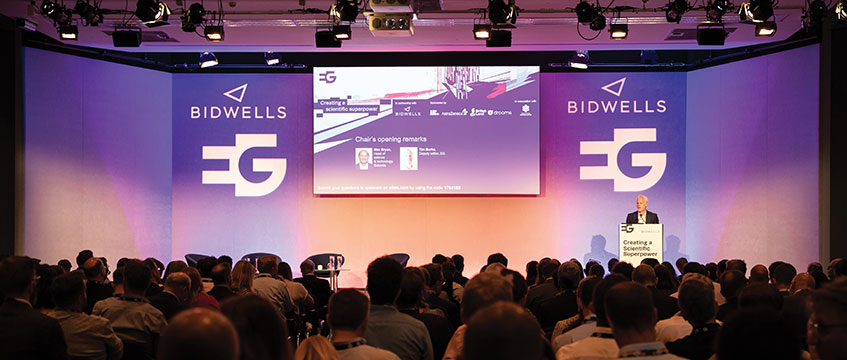Talent, tenancy and transport: bolstering the UK’s science and tech sector
The UK’s science and technology sector has an ambition to lead the world – but hard work is needed to ensure it has the talent, tools and space to shine.
EG and Bidwells’ second Creating a Scientific Superpower conference saw more than 450 guests gather at London’s QEII conference centre for a day of panels and presentations exploring the challenges ahead for the industry during these rocky economic times.
As well as leading names from the scientific industry, the audience heard from government ministers and real estate decision-makers.
The UK’s science and technology sector has an ambition to lead the world – but hard work is needed to ensure it has the talent, tools and space to shine.
EG and Bidwells’ second Creating a Scientific Superpower conference saw more than 450 guests gather at London’s QEII conference centre for a day of panels and presentations exploring the challenges ahead for the industry during these rocky economic times.
As well as leading names from the scientific industry, the audience heard from government ministers and real estate decision-makers.
From AstraZeneca, which has invested $1bn (£766m) in building a new UK corporate headquarters, vice-president of discovery biology Steve Rees said the potential for the sector has never been greater.
“The past 10 years have seen a transformation in innovation and a transformation in the technologies that are available to us to understand disease, to identify new types of medicines that will allow us to treat disease, and then the ability to understand which medicine we should give to which patient,” Rees said.
“These are things we couldn’t do just 10 years ago that create a massive opportunity for the UK, but also for global society at large to move from a situation where our medicines treat the symptoms of disease to a situation where our medicines cure disease and, increasingly, maybe also prevent disease.”
Real estate’s role
The task of creating the right space for the sector to flourish – and, crucially, enough of that space – was a key theme of the day’s discussions.
“As custodian of places and property, our role is to reimagine, repurpose and look after those assets in the long term,” said British Land’s Emma Cariaga. She highlighted the Canada Water scheme in south-east London, of which she is co-head, as well as the company’s work to reposition its Regent’s Place campus in central London and rethink its buildings as lab-focused homes for innovative businesses.
“From a commercial and socially responsible landlord and a long-term custodian, I think it’s something that we will continue to do on our assets, particularly the campuses that we develop across London. Regent’s Place is at the start of that journey, and then Canada Water is a development for the future,” she added.
Jenny Gardner, director of development at Brookfield-backed ARC, said continued proactive engagement with tenants is a must, once they take space.
“I like to think of our businesses and our buildings as more than just the four walls and a lease,” Gardner said. “Thinking about how our buildings can accept some of the pent-up demand from various industries within our clusters, thinking about intentional design and how we can make sure that we are listening to what people need and what they want and where they are going, three, four or five steps into the future.
“[We need to] make sure that we are accommodating that growth within our masterplans, our buildings and wherever we can within our portfolio.”
Rail over road
Transport too was flagged as a crucial factor in helping the sector meet its potential.
Neil Sachdev, chair of the East West Railway Company, bemoaned the difficulty of navigating the Oxford-Cambridge Arc by road.
“Travelling east to west is just impossible [without the line],” Sachdev said. “I travelled from Cambridge to Milton Keynes last week and it took two and a half hours. And to get to Oxford, there is another hour and a half, possibly. It is stopping growth in the area.
“The idea of creating East West Rail was to enable the Arc in creating innovation, being that superpower that we are talking about in science. It’s about building the tech corridor that we know we could do, but also making sure people can live there as well. By connecting it up, we will make the journeys easier, affordable and also greener.”
The project will ultimately create £110bn of GVA for the economy, Sachdev added.
“This is enormous growth. This is going to impact not only the towns along the region and the region as a whole, but also enable the UK to really step up and be counted for what it’s known for – great innovation, particularly in sciences.”
Fixing what is broken
Then there is talent. “That is another real challenge,” said Glenn Crocker, executive director at Pioneer Group. “Speak to probably anybody in the room, and they will say that getting the right people in is always challenging.
“It has become worse since Brexit, because you used to be able to get people easily across from anywhere in the EU, and now it takes six months plus to get a visa, which people aren’t going to wait for. So we are seeing companies that used to have maybe 30% of their staff from the rest of the EU down to about 10%, and then struggling to fill some of the other spaces.”
Crocker added: “There are a few things where I think we are shooting ourselves in the foot as a country that could be relatively easily fixed. It’s not like there is a massive amount of money that necessarily needs to be shoved at the industry. It’s fixing the things that are broken and need to be corrected in order for businesses to work and to flow.”
Not that the country’s existing offering is failing to deliver. When Moderna chose to make the UK its main base outside of the US, it did so with an eye on a range of selling points, said Matthew Snape, vice-president of paediatric and maternal vaccine clinical development.
“They were just looking at what was happening in the UK during the pandemic,” Snape said. “The extraordinary studies that were run, studies such as the Oxford-AstraZeneca studies, were able to enrol into these large phase-three studies extraordinarily quickly, with high-quality data and using the NHS as an asset to access databases and use that for research.
“What they could see was highly skilled staff, highly skilled researchers, a highly willing population, and in that context a very willing regulator as well.
“They were very impressed by all of those things, as well as the Oxford-Cambridge geography – that there was this epicentre of excellence.
“That is why they wanted to locate physically around that area – and they made that very clear.”
With no sign of complacency from conference speakers, panellists acknowledged the challenges ahead for the sector. But as Moderna’s journey shows, efforts will be building on an existing base that no one can ignore.
To send feedback, e-mail tim.burke@eg.co.uk or tweet @_tim_burke or @EGPropertyNews
Photo @ Louise Haywood-Schiefer











